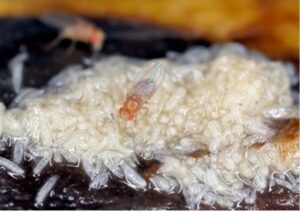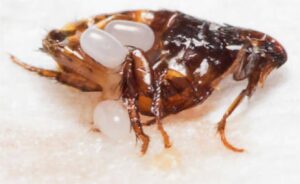Which Came First, the Pest or the Egg? The Overlooked Origins of Infestations
When it comes to pest control, many businesses focus on eliminating the visible problem -rodents scurrying across warehouse floors, insects crawling under ovens in a commercial kitchen, or flies posing a health threat on a restaurant patio. But what about the threats you can’t see?
Pest eggs are an often-overlooked risk that can lead to recurring infestations, even after adult pests have been removed. These tiny, resilient capsules are typically hidden in cracks, crevices, and hard-to-reach areas waiting for the right conditions to hatch and restart the cycle.
At Sprague, we know that stopping pest infestation at its source means targeting pests at every stage of their lifecycle, including the egg stage. Whether it’s cockroach ootheca, spider sacs, or stored product pest eggs camouflaged in food processing environments, a proactive approach is essential to prevent a minor issue from becoming a costly problem for commercial property managers and owners.
“Understanding where pest eggs are found, how they survive, and the best strategies for eliminating them can make the difference between a one-time issue and a persistent pest challenge for commercial properties,” says Edna Alfaro Inocente, Regional Entomologist for Sprague Pest Solutions.
Here’s what commercial properties need to know about these often-hidden threats that are difficult to detect with the naked eye:
Flies

Fruit flies
Fly eggs, both small and large, often resemble grains of rice. Large flies; such as house flies (Musca domestica), stable flies (Stomoxys calcitrans), and blow flies (Family Calliphoridae); lay their eggs in organic matter and manure. House flies, a common nuisance in food processing facilities, are drawn to food waste and garbage and will lay eggs wherever this material is found. These eggs are laid in clusters and in large numbers, heightening the risk and reinforcing the need for strong cleaning and sanitation protocols.
Small flies, including fruit flies (Drosophila melanogaster), prefer to lay their eggs on fermented fruits and vegetables rather than decomposing matter, which sets them apart from their larger relatives. To reduce the risk of infestations from small drain flies (Family Psychodidae), drains should be cleaned regularly to remove organic buildup that serves as breeding ground.
Bed Bugs
 Bed bug eggs are nearly impossible to see with the naked eye, which is part of what makes these pests so challenging to manage. Until the eggs hatch, you may not see any visible evidence – whether it’s under a hotel bed or within the seating area of an emergency care facility – and by then, the infestation has likely spread.
Bed bug eggs are nearly impossible to see with the naked eye, which is part of what makes these pests so challenging to manage. Until the eggs hatch, you may not see any visible evidence – whether it’s under a hotel bed or within the seating area of an emergency care facility – and by then, the infestation has likely spread.
Bed bugs do not lay eggs in the same areas where they feed, such as mattresses or couch cushions. Chemical treatments are typically ineffective against the eggs because they cannot penetrate the shell. However, non-chemical methods such as heat treatments, steaming and HEPA vacuuming are highly effective against all life stages, including eggs.
Fleas

Flea with eggs.
Fleas take a volume-based approach to reproduction, laying eggs on animal bedding, carpets, rugs, and other soft surfaces. In fact, research shows that eggs make up roughly 50% of typical flea infestations.
Like most insects, flea parents do not protect their offspring. This “quantity over quality” strategy explains why fleas can become such a widespread nuisance. Flea eggs can be seen if on pets with fleas when you part their fur – the “salt and pepper” flakes you see are flea eggs and flea feces. The best control strategy includes regular washing of bedding in hot water and using veterinarian-prescribed treatments for pets.
Cockroaches
Cockroaches differ from many insects in that they do not undergo complete metamorphosis. They skip the larval stage and emerge directly from their ootheca (egg case) as nymphs. This casing protects them until they’re ready to become active threats – especially in food-related facilities like quick-service restaurants, grocery stores, and commercial kitchens.

German cockroach ootheca.
The number of nymphs in an ootheca varies by species – from 7 to 16 in Oriental cockroaches (Blatta orientalis) to as many as 40 in German cockroaches (Blattella germanica), the most encountered cockroach specie. Unlike fleas, German cockroach mothers are protective. They often keep the ootheca with them until the nymphs’ hatch.
For most species of cockroaches, ootheca are typically hidden in protected areas near food sources such as inside drains, high up in cabinet drawers, or within kitchen or food processing equipment. The most successful of all cockroaches, the German cockroach, protects her ootheca until right before hatching – ensuring an incredibly high survival rate!
Mosquitoes
Mosquito egg-laying habits vary by species. Culex mosquitoes – known for transmitting viruses like West Nile and encephalitis – and Anopheles mosquitoes lay eggs directly on stagnant water sources like ponds, marshes, swamps, and water treatment facilities.
Aedes aegypti mosquitoes, by contrast, prefer to lay eggs on the inner walls of water-holding containers such as planters, discarded tires, and playground equipment. Some Aedes species also lay eggs along the water-soil line or in vegetation prone to flooding.
Spiders
Spider eggs typically appear as small, round sacs or clusters encased in silk for protection. These sacs are usually hidden in less-trafficked areas like storage rooms, closets, or high shelving units.
Black widow spiders are highly protective of their eggs. The female often keeps the egg sac with her – sometimes even carrying it on her back – until the eggs hatch.
Stored Product Pests
Stored product pest eggs are extremely small and often blend seamlessly with their surroundings. For instance, the white eggs of flour beetles are nearly invisible in flour. However, there are exceptions, bean weevil eggs, for example, attach to the surface of beans and may be easier to spot.
Egg structures can vary by species, with some featuring grooves or pores that aid in identification and influence control methods. Because of their size and camouflage, SPP eggs are rarely detected without magnification or professional inspection.
Cracking the Egg
Recognizing the early signs of a pest problem, especially the presence of eggs, is key to preventing a full-blown infestation. For pests like bed bugs and fleas, eggs are often hidden and difficult to spot, but if you’re seeing adult pests, it’s likely that eggs are already present.
Avoid disturbing infested areas. Moving bedding or furniture without proper containment can spread eggs to new locations. Encourage apartment and condominium residents to seal potentially infested items in plastic bags before handling, and to avoid excessive cleaning or vacuuming until a pest professional has assessed the situation.
With pests such as fruit flies, identifying and eliminating the source is essential. Dispose of overripe fruit and clean drains to remove eggs and larvae. As with all pests, regular sanitation and cleaning protocols are critical.
Trying to treat a pest problem without a clear plan can sometimes make things worse. That’s why communication with your pest management service provider is so important. If you see something unusual – whether it’s a pest sighting, droppings, damage, or a condition that attracts pests – report it immediately. Early detection and a coordinated response offer the best chance to eliminate pests and keep them from coming back.
